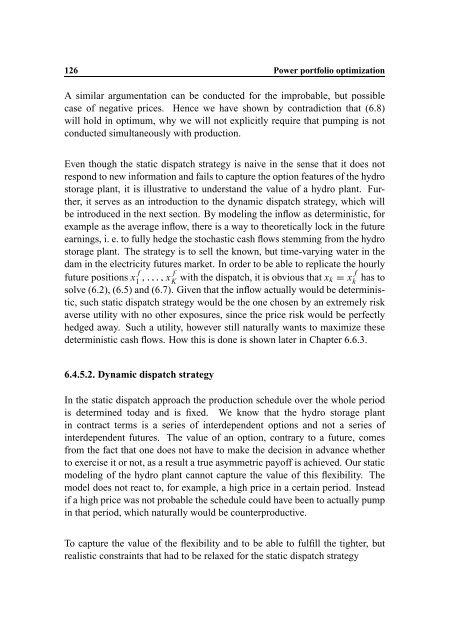Hedging Strategy and Electricity Contract Engineering - IFOR
Hedging Strategy and Electricity Contract Engineering - IFOR
Hedging Strategy and Electricity Contract Engineering - IFOR
You also want an ePaper? Increase the reach of your titles
YUMPU automatically turns print PDFs into web optimized ePapers that Google loves.
126 Power portfolio optimization<br />
A similar argumentation can be conducted for the improbable, but possible<br />
case of negative prices. Hence we have shown by contradiction that (6.8)<br />
will hold in optimum, why we will not explicitly require that pumping is not<br />
conducted simultaneously with production.<br />
Even though the static dispatch strategy is naive in the sense that it does not<br />
respond to new information <strong>and</strong> fails to capture the option features of the hydro<br />
storage plant, it is illustrative to underst<strong>and</strong> the value of a hydro plant. Further,<br />
it serves as an introduction to the dynamic dispatch strategy, which will<br />
be introduced in the next section. By modeling the inflow as deterministic, for<br />
example as the average inflow, there is a way to theoretically lock in the future<br />
earnings, i. e. to fully hedge the stochastic cash flows stemming from the hydro<br />
storage plant. The strategy is to sell the known, but time-varying water in the<br />
dam in the electricity futures market. In order to be able to replicate the hourly<br />
future positions x f Ü<br />
áaá@á<br />
1<br />
x f K with the dispatch, it is obvious that x k x f<br />
k<br />
has to<br />
solve (6.2), (6.5) <strong>and</strong> (6.7). Given that the inflow actually would be deterministic,<br />
such static dispatch strategy would be the one chosen by an extremely Ü risk<br />
averse utility with no other exposures, since the price risk would be perfectly<br />
hedged away. Such a utility, however still naturally wants to maximize these<br />
deterministic cash flows. How this is done is shown later in Chapter 6.6.3.<br />
6.4.5.2. Dynamic dispatch strategy<br />
In the static dispatch approach the production schedule over the whole period<br />
is determined today <strong>and</strong> is fixed. We know that the hydro storage plant<br />
in contract terms is a series of interdependent options <strong>and</strong> not a series of<br />
interdependent futures. The value of an option, contrary to a future, comes<br />
from the fact that one does not have to make the decision in advance whether<br />
to exercise it or not, as a result a true asymmetric payoff is achieved. Our static<br />
modeling of the hydro plant cannot capture the value of this flexibility. The<br />
model does not react to, for example, a high price in a certain period. Instead<br />
if a high price was not probable the schedule could have been to actually pump<br />
in that period, which naturally would be counterproductive.<br />
To capture the value of the flexibility <strong>and</strong> to be able to fulfill the tighter, but<br />
realistic constraints that had to be relaxed for the static dispatch strategy
















